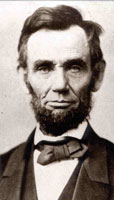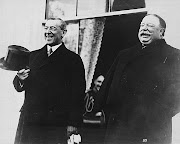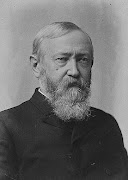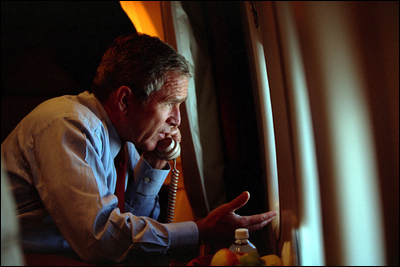 Years in office: 1789-1797
Years in office: 1789-1797 Pre-service occupations: general in chief, delegate to the constitutional convention, planter, colonial officer, surveyor
Key events during his administrations: Establishment of the judiciary (1789); North Carolina and Rhode Island ratified Constitution (1789 and 1790); new states: Vermont (1791), Kentucky (1792) and Tennessee (1796); Whiskey rebellion (1794); Jay Treaty (1794)
Presidential rating: Highly successful and revered
ESSAY
He’s known as the “father of his country,” but more people seem to know him as an immobile face on Mount Rushmore and the one dollar bill, or as a silly cartoon character hawking cars, furniture and bargains galore on Presidents Day every February. Two recent books attempt to close the personal distance between us and this enigmatic man (see Resources below) and they have done a fine job—as long as people read them, of course.
So who is this man, this icon, honored with an obelisk in the capital city named after him? Is the original G. W. still “first in war, first in peace, first in the hearts of his countrymen?” Is this man, whose every image depicts him with tightly clenched teeth, still even taught in schools today? Or is he a mere passing reference, dismissed—even reviled—by some because he owned slaves?
Surveys of presidents generally put Washington at or near the top of the presidential pile for one overriding reason—and it is a huge one. At the end of his second term, Washington turned his back on power—the second time in his life he had done so—and refused to run for a third term. (The first occasion came at the end of the war when he declined some of his officers’ counsel to seize power.) How many men would have had the fortitude of character to turn their backs on such power? Many of his admirers and friends were actually willing to make him king for life, though his enemies—he did have them—abhorred the idea. Washington would have none of it. Instead, he went home to his beloved Mount Vernon estate. And in his will, he freed his slaves.
But what of the entirety of his presidency? His final act set the model for succession. But how did the rest of it go? Since this was brand-new territory, we must gauge Washington against himself, not any other person.
“Mr. President”
The most important points to keep in mind while gauging George Washington as president are these:
1) he really didn’t want to be there;
2) he played the expected yet much needed role of figurehead; and
3) while acting as figurehead, he governed as a strong chief executive ever mindful of the specter of monarchy.
Washington was sometimes likened to “Cincinnatus,” the successful Roman general who eschewed political power but was nevertheless called out of retirement to become dictator. (Biographer Joseph Ellis sometimes calls him this as well.) He reluctantly assumed the presidency (assumed is the correct word, for his election was unanimous), but he, ever mindful of his prestige and reputation, made sure that the office was treated with respect and dignity. Although it’s believed he didn’t mind the accolades given him, and even though he hailed from aristocratic stock, outwardly he endeavored to quash any hints of monarchy. It’s no small point; in 1789, the man from Virginia was revered. He was the closest thing to a king that America had, and had he sought to make himself king, it wouldn’t have been much of a stretch. He made sure the executive would be addressed with the simple “Mr. President.” He also acceded to drawing a salary for the same reason; declining the $25,000 pay could have set a bad precedent that only men of great wealth, who could afford to not be paid, could be president.
Figurehead and executive
Washington was indeed a figurehead, being the one person to whom everyone could look to as the hero of the nation. He took the role quite seriously, because it was tied in with his reputation and prestige, and a figurehead was precisely what the young nation needed at that time: a rallying point. Washington saw himself—and was
 seen—as the man holding the fragile new republic together. Ultimately, it was the reason he acceded to become the first president.
seen—as the man holding the fragile new republic together. Ultimately, it was the reason he acceded to become the first president. And it was fragile; Washington was keenly aware that certain things just could not be done lest they rend the young nation apart. Washington himself is the answer to the question of why the founding generation did not deal with slavery. The prickly problem had to be punted. No moral coward, Washington knew that even his reputation would not be enough to keep the nation together if slavery were dealt with during his time. He believed—undoubtedly correctly—that the United States of America would shatter and die over slavery if the issue came to a head then. The nation needed first and foremost to come together. (The Virginian believed that the issue would be tackled in the early 1810s, but the solutions were compromises that eventually led to war.)
But Washington wasn’t merely a symbol, as critical as that need was to the early nation. He was also a leader. Washington the chief executive was little different than Washington the general, colonial officer and land speculator. Biographers James MacGregor Burns and Susan Dunn describe the first president as both a transactional and a transformational leader, meaning he was simultaneously a smart CEO and an intelligent precedent-setter. When organizing his cabinet, Washington didn’t merely assemble cronies and toadies, like a king might do. He delegated to smart and able men. But he also made the final decisions, just like he did on the battlefield. Often he was content to delegate many matters to his official family, and others he took directly on himself. One such matter was a failure: He sought autonomous status for Indian nations to the west of America in hopes that they would remain safe/autonomous as America pushed west. But the effort failed. How often do you associate failure with President Washington, by the way?
Probably the greatest disappointment personally to Washington was that his official family proved to be the genesis of American political parties—something the great Virginian abhorred. The split was of course between Jefferson and Hamilton, the former searching for the democratic agrarian paradise that was the genesis of the Democratic-Republican party, and later because the Democratic Party (after Jackson); and the latter, first the Federalists, and eventually, a half century later, the Republicans.
It’s interesting that Washington kept the tension within his official family going for so long—and even approved of it. He appears to have enjoyed it to some extent because it gave him more than just one opinion. Like a good field commander, Washington didn’t care to be surrounded by “yes” men. However, he mistakenly believed that Jefferson—and his unofficial cabinet member, Rep. Madison—who spoke behind his back were prodigal sons who would eventually see the error of their ways. Jefferson even attributed some of Washington’s actions, such as the suppression of the Whiskey Rebellion in 1794, to senility that Washington did not have. Washington finally understood in 1796 that Jefferson was no prodigal, but a two-face who thought him senile and controlled by others.
Reputation on the line
Near the end of his term, Washington decided that he needed to run for a second term. He had had designs of serving as the figurehead until the country got going, but the divisions in his official family convinced him that he needed to stick around a little while longer.
Good thing, too. The president proved adept in foreign affairs, rejecting Madison’s proposal for trade war with England over claims left over from the Revolution. Instead, the president sent Justice John Jay to England to work out a peace. In short, Washington put his tremendous reputation on the line and got the Jay Treaty ratified by the Senate (1794). The treaty succeeded in averting a needless war, expanded trade with England and opened the west—but it also sh
 arpened the political divisions between the Hamiltonians and Jeffersonians. The treaty was wildly hated at the time, because the Jefferson/Madison Republicans wanted a showdown with England, not a compromise. Washington’s reputation took damage. But Washington, displaying exceptional wisdom and forward-thinking, looked past the passion of the moment and knew a new war with England would be ruinous. So he did the unpopular thing, and signed the treaty. It turned out to be a very good thing. The second war with England was averted for 20 years—and we know how well that one went.
arpened the political divisions between the Hamiltonians and Jeffersonians. The treaty was wildly hated at the time, because the Jefferson/Madison Republicans wanted a showdown with England, not a compromise. Washington’s reputation took damage. But Washington, displaying exceptional wisdom and forward-thinking, looked past the passion of the moment and knew a new war with England would be ruinous. So he did the unpopular thing, and signed the treaty. It turned out to be a very good thing. The second war with England was averted for 20 years—and we know how well that one went. By the end of the second term, Washington had had enough. His enemies were speaking brazenly about him now, raising phantom specters of King George and even spreading phony charges that he had been a British spy. (Note that Washington, as revered as he was, was no more free from vicious partisanship than most any other president.) Also, his normally robust body was failing, and he believed he could finally retire in good stead, having shepherded the young nation through its earliest years.
He always remained popular, but the grumbling about the “new King George” weighed on him. If there had been any question about a third term, the yearning for Mount Vernon and the wish to avoid monarchy settled the matter.
Final assessment
This should really come as no surprise, but Washington truly does deserve his reputation. In presidential rankings, he’s usually first or second, ahead or just behind Lincoln. And it’s usually his final act—declining to seek a third term and being made “president for life”—that clinches it for the rankers. But I found Washington to be an engaging president and commander in chief. He took the position seriously and treated it as a humbling honor, not a right to which he was due. He carefully weighed his options, and kept the Constitution, for which he had just labored, close at hand—and even vetoed two pieces of legislation because he believed that they violated that Constitution.
Make no mistake: Washington succeeded admirably in striking the perfect balance between being “Cincinnatus” and an engaged chief executive who set the proper tone, expectations and precedents for the office. In short, he was a figurehead when needed, a master of delegation when needed and an active executive when needed. He set the proper tone for his successors, and showed them the way. MacGregor and Burns have something fascinating to say on the model that Washington set. The nebulous force “conventional wisdom” says that presidential second terms are usually disasters. With that in mind,
Washington lamented the partisanship. But if every president would follow his model for leadership, he would do well in office, at least in how he conducts his affairs. And when looking at President Washington compared to many of those who seek the office today, or who have sought it in the last four presidential election cycles, almost all of them fall far short of the Virginian.“It has been said that during his first term Washington taught his successors how to be president and during his second term how not to be president. This is a half-truth at best. Better to record that during his first term in office, he set up the executive branch of government, transformed the economic landscape with modern, forward-looking policies, [Big Mo editor’s note: this was through his “son” Hamilton’s brilliant fiscal ideas], successfully presided over the quarreling members of his cabinet, united diverse states and populations behind a new unified government and his own administrative and symbolic leadership…
And better to grant that during his second term, though he established the executive branch as the sole formulator of the nation’s foreign policy, his own foreign policy, no less than some of his domestic policies, polarized citizens and spurred the development of political parties. Despite his unrivaled grasp of the interplay between ambitions and interests, Washington never fully understood the vital need for parties and partisanship as the only way, in the long run, to organize safely and creatively the grand conflicts inevitable in a healthy, dynamic democracy.” (MacGregor and Burns, p. 97)
This isn’t hero worship. In the final assessment, Washington was a hugely successful president, both in how he conducted his affairs in office, and how he left that office. Washington provided an excellent role model for chief executives: reluctant service, smart selection of officials, judicious delegation, careful active leadership and prescience of his constitutional duties. He knew when to be a figurehead and when to lead. He knew when his reputation could get something done that was not popular (today we call this “spending political capital”) for the good of the country. He did not take advantage of the reverence the American people afforded him by turning the new presidency into a royal office or a dictatorship. He acted with admirable restraint, and strove to conduct his affairs within the constraints of the new Constitution.
It’s a shame, though, that his name is not celebrated in schoolhouses across the land like it once was, and that he has been relegated to the mundane “Presidents Day” holiday.
Resources
Two 2004 biographies are definitely worth your time: Joseph P. Ellis’ His Excellency: George Washington and James MacGregor Burns and Susan Dunn’s George Washington (The American Presidents series).
You can also spend a career perusing Washington’s papers. I have a reprint of Washington Irving’s (Legend of Sleepy Hollow) somewhat fawning and very flowery multi-volume biography of Washington, but its value is found more in entertainment.
Illustrations
1. Gilbert Stuart's full-length painting of President George Washington. (White House Historical Association.)
2. A Currier & Ives print published sometime between 1835 and 1856. (Library of Congress Prints and Photographs Division.)
3. Gilbert Stuart’s famous unfinished portrait of Washington, which appears on the $1 bill. (Library of Congress Prints and Photographs Division.)








No comments:
Post a Comment